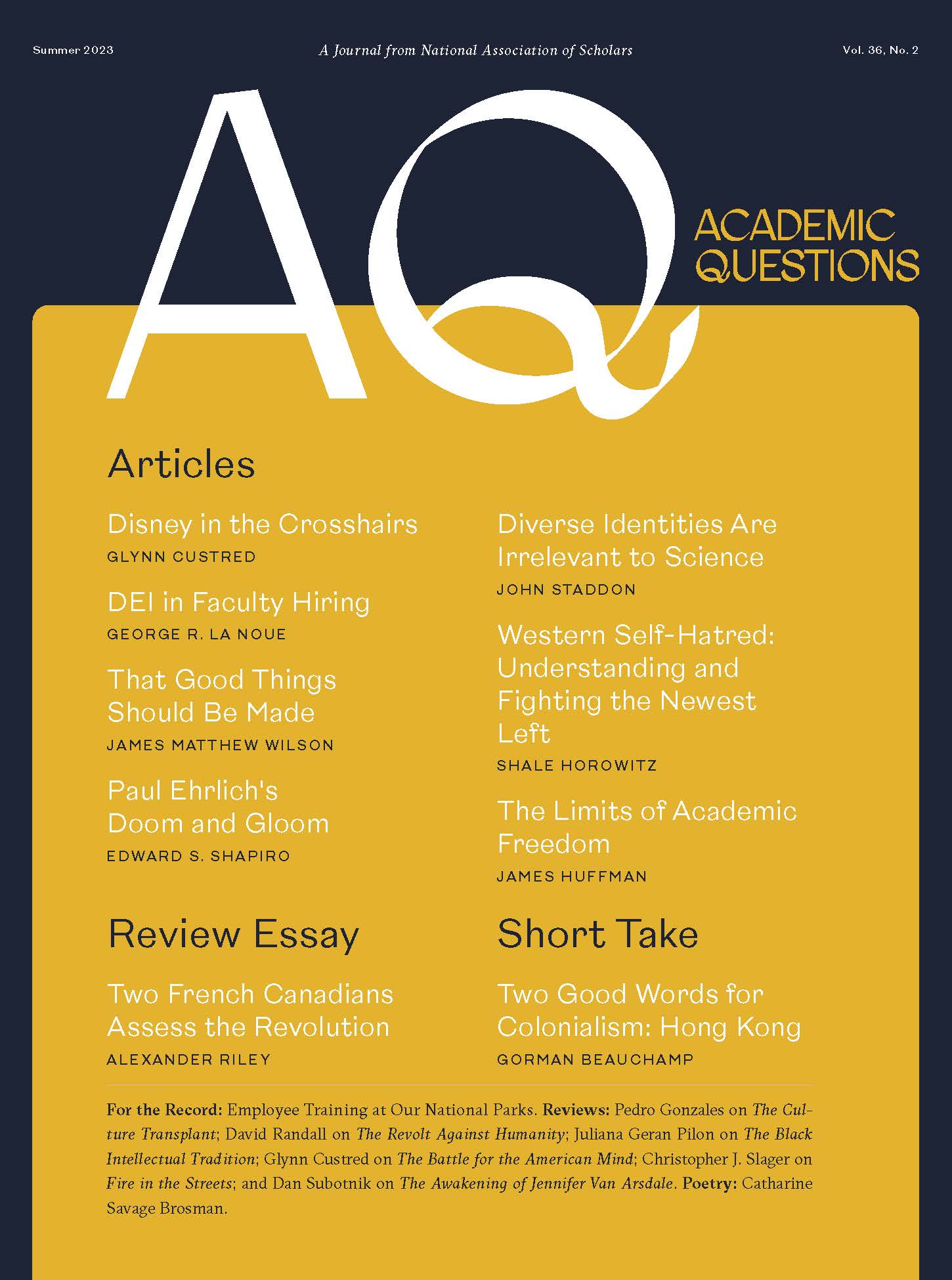The Black Intellectual Tradition: Reading Freedom in Classical Literature, Anika Prather, Angel Adams Parham, Classical Academic Press, 2022, pp. 344, $29.95 hardcover.
Academics seeking to atone for past sins against victimized populations are often engaged in voluble self-flagellation, hastening to demonize classic writings as inherently racist. But a new book by two black professors indicates that some faculty possess a strong commitment to preserve—mirabile dictu—“our common heritage in the classics and the liberal arts.” The book is a joy to read, the flaws too minor to mar the lasting impression of hope.
Writing in her Foreword St. John’s College tutor Zena Hitz recounts how she first met one of the authors, Anika Prather, addressing a group of black college students attending a program at St. John’s. “As she spoke of her own journey of healing through the Great Books,” writes Hitz,
I was standing in the back, in tears. To judge from the media, we teachers have a choice either to follow prefabricated and patronizing rubrics of “inclusion,” each ethnic group with its own reading list, or to retreat defensively onto familiar ground, clinging to our old reading lists and to conversation partners who look like us. Both options involve grave moral and spiritual dangers.
Hitz later also met the book’s co-author, Angel Adams Parham, who had independently discovered that “the great Black thinkers and leaders were educated by reading canonical authors.” The canon, writes Parham, is “a space of freedom, as we all know,” provided the conversation is respectful—“drawing from common ground, each of us finds our way, offering something different to the conversation based on our totally unique path through time, space, and experience.” Equally unequal in God’s image, travelling our separate paths together.
One of the most illustrious of these leaders was the orator born in slavery, Frederick Douglass, his sensibility nourished on classical texts, especially Greek and Roman. They catapulted him to the very pantheon of American letters. Like the President he came to love, Abraham Lincoln, in 1847 Douglas commended slaves to read the Bible, condemning its misuse in defense of slavery. As “peculiarly the companion of liberty,” he hailed it as the most fundamental pillar of equality and toleration. Its message as captured in the Declaration of Independence, foundational to America.
Richard Wright similarly resonated to the canon, embracing classics from throughout the globe. Writing in 1937 he argued that the black intellectual tradition, far from being endangered by an ecumenical education, had to join the ranks of the great writers. But for that, it needed to be richly nurtured:
Eliot, Stein, Joyce, Proust, Hemingway, and Anderson; Gorky, Barbusse, Nexo and Jack London no less than the folklore of the Negro himself should form the heritage of the Negro writer. Every iota of gain in human thought and sensibility should be ready grist for his mill, no matter how far-fetched they may seem in their immediate implications.1
This approach was shared by Martin Luther King—a formative inspiration for both Prather and Parham. His 1961 talk “Love, Law and Civil Disobedience,” for example, was replete with classical and biblical references. Using Ovid’s verse “I see and approve the better things of life, but the evil things I do,” MLK acknowledged the gaping divide between rhetoric and action, alongside the inescapable paradox of man’s nature as torn between good and evil. Though acceding to Plato’s view of the human personality as “like a charioteer with two headstrong horses, each wanting to go in different directions,” he argued that “in spite of this there is something in human nature that can respond to goodness. To put it in theological terms, the image of God is never totally gone.” The book’s authors share King’s biblical vision: God created not races, but everyone in his image.
Can anything be more trivial than skin color to capture the essence of someone’s soul? As Anika Prather recounts in her autobiographical introduction, her choice of teaching as a profession was fueled by a strong “desire to show students how America is a melting pot of so many different cultures, but together we are America.” But she soon became frustrated by the limited curriculum she had to teach in public schools. Fortunately, her parents were eager to have her join them in starting a classical school. It changed her life.
Reading Thucydides, for one, was “instantly mind altering. . . . Thus for the next six years, I taught Black students about the works of the canon and how they connect to the lives of Black people.” Through her lessons, she was “able to help students see how the themes such as virtue, truth, beauty, love, and friendship that were threaded throughout the books were relevant to every human being.” It was perfectly clear that “the classical tradition is part of Black history . . . [indeed] an integral part.” A protestant minister’s daughter, she would later receive her doctorate. By 2015, she opened her own classical school. Her students read the Great Books, learn Latin, logic, and classical history interwoven with black and African history.
Angel Parham’s journey was similar. She too became committed to exposing as many people as possible to the canon. Beginning with toddlers! For she herself had encountered it through homeschooling her two girls, aged two and five, when as a full-time professor on a sabbatical at Princeton, she used materials provided by the Sonlight home-schooling curriculum. Every morning they would pray, read, discuss a Bible lesson, and then immerse themselves in one of the stories—many of them children’s classics.
Eventually Parham was to meet Danielle Bernadette Dukes, Director of the Classical Conversations campus, who had invited her to attend an informational session about her program. The experience was a “pivotal moment” for Parham. Based on the use of distinct historical time periods, which structured the readings, it seemed perfect for her children, who for the next eight years were enchanted to discover the classics. As was she: “For instance, my introduction to Homer’s Odyssey was reading a children’s version aloud to my daughters,” explains Parham. Her strategy involved “finding a classic book that had been adapted for a young audience and then finding adaptations of the same book for progressively higher levels. We then revisited that book every time we came back in the cycle to the relevant time period.” By ages eight and eleven, they had graduated to a sophisticated prose version of the Odyssey by Gillian Cross.
Not that the Parhams were especially privileged: their home in New Orleans at the time was in a largely low-income and working-class African American community. But she learned of many mothers in her neighborhood eager to supplement their children’s education which they felt was inadequate. The solution presented itself: she and Ms. Dukes decided to co-found the Nyansa Classical Community2, an afterschool program where children read classical literature and put it “into dialogue with African American history and culture.” She was thus able to expose underprivileged children to the legacy of humanity, expanding their minds and hearts.
But she was not finished educating herself. Ten years ago, she decided to become better versed in the Great Books, including Tocqueville, Rousseau, and Dante in addition to the ancient Greeks and Romans. Profoundly affected by classical learning, “it has become a motivating passion in my life and I am eager for others to share in it.” Although today’s political climate has been highly critical of a form of education that makes classical and canonical readings central to the curriculum, “I stand by the importance of classic texts. I know, moreover, that I am not unique in being a Black woman intensely drawn to the classics.” She would thus be joining an extraordinary community of parent-educators that has since mushroomed.
The idea for Sonlight had come to John and Sarita Holzmann in 1989, after realizing that they couldn’t afford private Christian schools for their three children and decided to start homeschooling. They were also among the growing numbers of parents frustrated with the increasingly anti-traditionalist ethos in the public schools. By the 1990s, the Society for Classical Learning had established a network of Christian classical schools in America, which now has over three-hundred schools teaching more than forty-thousand students. The most recent National Symposium for Classical Learning is being hosted by the Great Hearts Institute, whose academies network educates about 20,000 students each year in Arizona and Texas in over thirty public charter classical schools.
A few years ago, Great Hearts opened an Institute for Classical Education specifically in order to assist schools and homeschoolers who want to adopt classical education. As Eric Cohen and Mitchell Rocklin note in Mosaic,
the Classical Charter Schools network operates four charter schools in the South Bronx that have received awards from the U.S. Department of Education for their success in serving underprivileged children. Memoria Press and the Highlands Latin Academy have produced a particularly outstanding Latin curriculum, helping to revive a subject that was dying. They now oversee a network of schools and disseminate a remarkable K-12 curricula to Christian schools, public charter schools, public school districts, and home-schooling families. The Classical Academic Press [CAP], which began in 2001, also services both Christian and non-Christian audiences.3
Its latest release is the book here under review, a true milestone.
The inclusion of many well-known black American orators and writers who had found canonical texts indispensable to their work makes the book’s length (344 pages) well worth it. Consider the story of former slave Ohaudah Equiano, probably born in South Carolina in the mid-1700s, whose experience with whites ranged from the most treacherous to exceptionally kind. Having become literate through a white patron, he would later be able to advocate for himself and other slaves by writing their stories. In a footnote, Parham remarks how important it is “to point out and discuss with students the role of White patrons as this helps to emphasize that no group of people is monolithically good or bad.” This should “help us to think through our own positions today with respect to various social evils.” To think, each of us, for ourselves.
More recent black writers include Nobel Prize winning novelist Toni Morrison alongside the distinguished evangelist Soong-Chan Rah, who serves on the boards of Sojourners, World Vision, among others.4 Rah’s prize-winning 2015 book Prophetic Lament: A Call for Justice in Troubled Times, for example, encourages mourning without hatred, and posits, in Parham’s words, that those who work toward a world “filled with truth, goodness, and beauty not only grieve, but they also help us to see through the darkness toward the light.”
Anna Julia Cooper is the book’s central figure, an extraordinary woman who represents the ideal to which the authors ardently aspire.
Born a slave in 1858, she would go on to earn a bachelor’s degree, then a masters’, and eventually even a doctorate from the Sorbonne, later becoming president of Frelinghuysen University, a school devoted to the uplifting of black people. Named after Frederick Theodore Frelinghuysen, a New Jersey senator ardently opposed to Andrew Johnson’s efforts to dismantle Reconstruction, the university was a type of community college targeting older black students. By using classical and Christian writings alongside vocational training, it thus blended the approaches of Booker T. Washington, who had advocated the latter, and that of W. E. Du Bois, who insisted on the importance of the former. Cooper was devoted to its success, allowing poor students to live in her home while attending school.
The book includes several of Cooper’s writings that illustrate her true spirit. In one of her poems, she asks that no flowers be placed on her grave, “just the smell of sweet understanding,” its headstone identifying her merely as “Somebody’s Teacher on Vacation Now. Resting for the Fall Opening.” To which Prather responds, in the book’s concluding chapter: “May our lives release the sweet-smelling aroma of your passion and conviction to bring a classical education to all people no matter who they are or where they are from.”
Half a century later after Cooper’s death in 1964, the effort to integrate classical education in the curriculum continues its exponential growth. Today, teachers interested in creating curricula using the Great Books don’t have to go to the Sorbonne. They can go to the University of Dallas’s graduate program in classical education; Eastern University’s Templeton Honors College; St. John’s College; Arizona State University; Hillsdale College; or Houston Baptist University’s Master of Liberal Arts, which includes an emphasis on classical learning. “Taken together,” Cohen and Rocklin point out in their article in Mosaic, “this is the most exciting cultural movement in the West: an effort to renew our civilization by returning to its Jewish, Christian, and classical foundations, starting with our youngest children and building forward.”
Now there is something to celebrate.
Juliana Geran Pilon is a Senior Fellow at the Alexander Hamilton Institute for the Study of Western Civilization and author of An Idea Betrayed: Jews, Liberalism, and the American Left (2023). In the Spring 2020 issue of AQ, she penned our memoriam for historian and friend Paul Hollander, “Goodbye, Pali!”
1 Henry Louis Gates, Jr., Gene Andrew Jarrett, eds., The New Negro: Readings on Race, Representation, and African American Culture 1892-1938 (Princeton, NJ: Princeton University Press, 2007), 268 ff.
2 Nyansa is a word from the Akan language spoken in Ghana meaning “wisdom from learning.”
3 Eric Cohen, Mitchell Rocklin, “The Spirit of Jewish Classical Education,” Mosaic, February 6, 2023.
4 The Sojourners Community is an international community that was started in the early 1970s by a group of students at Trinity Evangelical Divinity School. World Vision International is a Christian relief and development organization.
Photo by Annie Spratt on Unsplash














